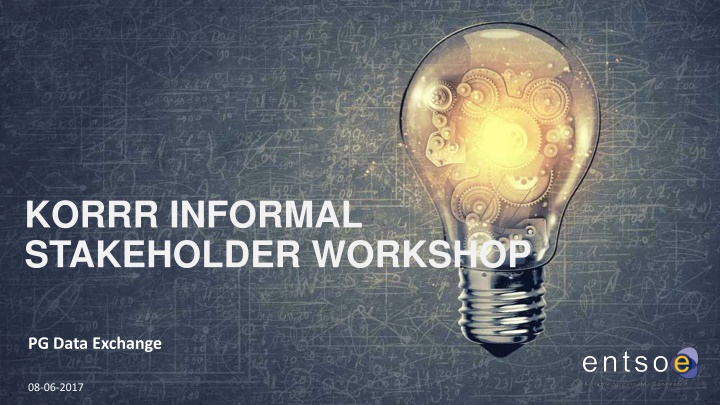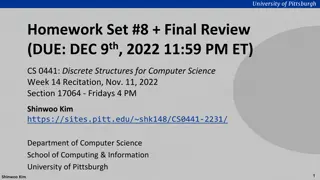
Operational Security Requirements and Data Exchange in Electricity Sector
Explore the key aims and structure of operational security requirements, data exchange, compliance, and training in the electricity sector. Learn about ensuring operational security, promoting coordination, enhancing transparency, and contributing to efficient sector operations.
Uploaded on | 4 Views
Download Presentation

Please find below an Image/Link to download the presentation.
The content on the website is provided AS IS for your information and personal use only. It may not be sold, licensed, or shared on other websites without obtaining consent from the author. If you encounter any issues during the download, it is possible that the publisher has removed the file from their server.
You are allowed to download the files provided on this website for personal or commercial use, subject to the condition that they are used lawfully. All files are the property of their respective owners.
The content on the website is provided AS IS for your information and personal use only. It may not be sold, licensed, or shared on other websites without obtaining consent from the author.
E N D
Presentation Transcript
KORRR INFORMAL STAKEHOLDER WORKSHOP PG Data Exchange 08-06-2017
SO GL aims definedin Article4(1) a) a) determining determining common operational security requirements and principles common operational security requirements and principles; ; b) b) determining common interconnected system determining common interconnected system operational planning c) c) determining common determining common load load- -frequency control processes frequency control processes and control structures; d) d) ensuring the conditions for ensuring the conditions for maintaining operational security throughout the maintaining operational security throughout the Union Union; ; e) e) ensuring the conditions for maintaining a ensuring the conditions for maintaining a frequency quality synchronous areas throughout the Union synchronous areas throughout the Union f) f) promoting the promoting the coordination of system operation coordination of system operation and operational planning; g) g) ensuring and enhancing the ensuring and enhancing the transparency and reliability of information transparency and reliability of information on transmission system operation; transmission system operation; h) h) contributing to the contributing to the efficient operation efficient operation and development of the electricity transmission system and electricity sector in the Union. transmission system and electricity sector in the Union. operational planning principles; and control structures; principles; frequency quality level of all level of all and operational planning; on and development of the electricity SO GL aims, struture, implementation 2
SO GL structure Title 1 Operational security requirements Title 2 Data exchange Title 3 Compliance Title 4 Training Part II Operational security Part I General provisions Part V Final provisions Title 1 Data for operational security analysis in operational planning Title 2 Operational security analysis Title 3 Outage planning coordination Title 4 Adequacy Title 5 Ancillary services Title 6 Scheduling Title 7 ENTSO-E Operational planning data environment Part III Operational planning Title 1 Operational agreements Title 3 Load frequency control structure Title 5 Frequency containment reserves Title 7 Replacement reserves Title 9 Time control process Title 11 Transparency of information Title 2 Frequency quality Title 4 Operation of load frequency control Title 6 Frequency restoration reserves Title 8 Exchange and sharing of reserves Title 10 Cooperation with DSOs Part IV Load frequency control and reserves SO GL aims, struture, implementation 3
SO GL implementationscope SO GL aims, struture, implementation 4
SO GL implementationtimelineincl. NRA approval (AnticipatedEIF 07/2017) SO GL aims, struture, implementation 5
KORRR approach: Timeline Preliminary Timeline 2017 2018 5 6 7 8 9 10 11 12 1 2 3 4 5 6 7 8 9 10 11 12 Data Exchange Art. 40(6) System Operation Guideline EIF Public Consultation Delivery by ENTSO-E Approval by NRAs Page 6
KORRR approach: Workshop Objectives Early involvement of stakeholders Present the current approach of the proposal Know interpretations and opinions Page 7
KORRR approach: Workshop Organization Time Subject 9:30 9:30- -10:00 10:00 Registration of participants, breakfast Introduction Coffee break Working session topics of interest for stakeholders Lunch Working session real time data exchange Coffee break Working session structural and scheduled data exchange Coffee break Summary of the workshop 10:00 10:00- -11:00 11:15 11:15- -12:45 13:30 13:30- -14:15 14:30 14:30- -15:15 15:30 15:30- -16:00 11:00 12:45 14:15 15:15 16:00 Page 8
KORRR approach Art Art. . 40 By 6 months after entry into force of this Regulation, all TSOs shall jointly agree on key organisational requirements, roles and responsibilities in relation to data exchange. Those organizational requirements, roles and responsibilities shall take into account and complement where necessary the operational conditions of the generation and load data methodology developed in accordance with Article 16 of Regulation (EU) No 2015/1222 40( (6 6) ) SO SO GL GL Page 9
KORRR approach General principles Who exchanges the information? How the information is exchanged? When is the information exchanged? How is the information stored?
KORRR approach: Main ideas Information is required to perform security analysis: Structural+ Scheduled-> Before real time Structural+ Real Time-> Real time analysis Each party shall have the information required for operational security. Where needed: When TSOs receive the information, it shall be shared with DSOs. When DSOs receive the information, it shall be shared with TSOs Page 11
KORRR approach Agreement among TSOs TSO TSO TSO Owner/ Aggregator Owner/ Aggregator Owner/ Aggregator DSO A DSO A DSO A Owner/ Aggregator Owner/ Aggregator Owner/ Aggregator DSO B DSO B DSO B Owner/ Aggregator Owner/ Aggregator Owner/ Aggregator National/TSO level Page 12
KORRR Coffee before the Topics of interest session Page 14
KORRR: Topics of interest Issues or concerns with the present draft of the KORRR? Incorporating Cascading & Centralised approach Appropriate level of detail KORRR Progressive or Conservative in approach? Sufficient flexibility for MS/Regional differences Are requirements clear enough and justified? ? Page 15
KORRR: Topics of interest What is your general approach to the Data Exchange between TSOs-DSOs-SGUs? Page 16
KORRR: Topics of interest What is your general opinion about the KORRR proposal? - Content - Structure - Applicability - Page 17
KORRR: Topics of interest What would you delete from the current KORRR proposal? Page 18
KORRR: Topics of interest What would you change from the current KORRR proposal? Page 19
KORRR: Topics of interest What would you keep from the current KORRR proposal? Page 20
KORRR: Topics of interest What would you add to the current KORRR proposal? Page 21
KORRR Time for lunch Page 22
Real time data exchange Real time data Structural data Scheduled data Who has to exchange the information How the information shall be exchanged When does the information has to be exchanged What information has to be exchanged How the information shall be stored Page 23
Data exchange General content Role Who What When How Storage TSO What is the trigger event for receiving updated data? How and in which format should the TSO receive data? What is the general role of the TSO? What data shall the TSO obtain? How should the data be stored by the TSOs? DSO What is the general role of the DSO? What is the trigger event for providing updated data? What data shall the DSO provide? SGU What is the general role of the SGU? What is the trigger event for providing updated data? What data should the SGU provide?
Real time data exchange General approach
Real time Data Exchange Discussion Do the proposal fits with current practices at national level? Did you expected more level of detail in the proposal? Is it necessary to harmonize SGUs connected at Transmission and distribution level? How shall DSO-DSO data exchange be addressed? Page 26
KORRR 15 minutes break Page 27
Structural data exchange Real time data Structural data Scheduled data Who has to exchange the information How the information shall be exchanged When does the information has to be exchanged What information has to be exchanged How the information shall be stored Page 28
Structural data exchange General content Role Who What When How Storage TSO What is the trigger event for receiving updated data? How and in which format should the TSO receive data? What is the general role of the TSO? What data shall the TSO obtain? How should the data be stored by the TSOs? DSO What is the general role of the DSO? What is the trigger event for providing updated data? What data shall the DSO provide? SGU What is the general role of the SGU? What is the trigger event for providing updated data? What data should the SGU provide?
Structural data exchange General approach
Scheduled data exchange Real time data Structural data Scheduled data Who has to exchange the information How the information shall be exchanged When does the information has to be exchanged What information has to be exchanged How the information shall be stored Page 31
Scheduled data exchange General approach
Real time Data Exchange Discussion Do the proposal fits with current practices at national level? Did you expected more level of detail in the proposal? Is it necessary to harmonize SGUs connected at Transmission and distribution level? How shall DSO-DSO data exchange be addressed? Page 33
KORRR Time to sum up Page 34
KORRR: general Clarity Flexibility: the less regulation the better Confidentiality Page 35
KORRR: real time Harmonization of exchanges between different SGUs Level of detail: frequency, redundancy, availability No duplication of data provision Responsibility of aggregator Page 36
KORRR: Structural and Scheduled Harmonization of exchanges between TSOs and NEMOS No duplication of information Use of flexibility markets Page 37
KORRR Thank you Page 38



















